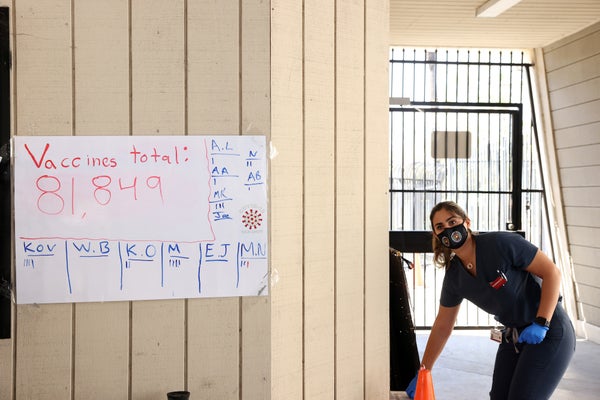Editor’s Note (12/21/21): This article is being showcased in a special collection about equity in health care that was made possible by the support of Takeda Pharmaceuticals. The article was published independently and without sponsorship.
As the Delta variant causes COVID-19 cases to swell, resurrects mask mandates and forces hospitals back to surge capacity, a familiar pattern is emerging. Like its less transmissible predecessors, this dangerous SARS-CoV-2 variant is especially affecting vulnerable populations in minority and rural communities, where vaccinations have lagged because of a perfect storm of reduced access to care, vaccine hesitancy, targeted misinformation campaigns and historically rooted mistrust.
Governments at all levels have taken notice of the disproportionate impact of COVID on these populations over the past year. At the federal level, President Joe Biden appointed a COVID-19 Health Equity Task Force by executive order. Many states, including Illinois, Louisiana and Tennessee, established similar task forces, working groups and councils dedicated to promoting health equity in the context of COVID-19. The National Governors Association recently highlighted Virginia’s task force as a model for other states. These conveners have helped motivate billions of dollars in federal and state investments to improve access to testing and vaccination in underserved areas. More recently, they have partnered with community leaders to disseminate effective messaging around masking, social distancing and vaccines amid evolving and sometimes confusing federal guidance.
While these efforts may help combat disparities in COVID outcomes, we must recognize that the root causes of these disparities existed for generations before the pandemic and will persist for generations afterward if health equity is not prioritized. COVID had a disproportionate impact on vulnerable populations because it exacerbated preexisting inequities in our society. Long-standing disparities in health, including the unequal incidence of comorbidities that increase the risk of poor outcomes from COVID, and in health-related social factors, such as housing insecurity and environmental exposures, contributed to the stark disparities in cases and deaths. These systemic disadvantages demand more than mobile clinics, temporary committees and short-term investments.
Rather they reflect the need for a more general and sustained commitment to health equity—indeed, to health justice from governments at all levels. President Biden signaled an interest in such a commitment through a series of executive orders on racial equity, while the Department of Health and Human Services continues to support focused efforts through its offices of minority health and health equity. At the state level, however, similar opportunities to promote health equity beyond the pandemic have received less attention, despite the highly local nature of the structural factors that drive inequities in health and disease.
Thus, we propose establishing a permanent director for health equity in each state. This office would be charged with coordinating the full range of state-level efforts to advance health equity. Achieving equity demands attention not only to downstream factors such as unequal access to medical care, but also upstream factors that extend beyond the health care sector. These upstream factors, often referred to as the social determinants of health, include education, housing and transportation, which collectively influence health and well-being more than medical care does. Similarly, the political determinants of health, including the unequal distribution of power in society and the growing disenfranchisement of certain populations, are increasingly recognized as critical to health equity.
Given that such a broad range of issues—many unrelated to health care itself—underlie health inequities, the directors for health equity would not only work within the health department, as is often the case with such roles today, but would collaborate with leaders across government, including the departments of education, housing and justice. In this way, they could help break down silos and orchestrate a pangovernmental approach to health equity that incorporates both upstream and downstream efforts. For example, after noting wide gaps in rates of diabetes across race in the western part of a state, a director could coordinate a comprehensive effort with targeted messaging from the public health commissioner and governor, specific guidance from the health secretary and Medicaid agency to local hospitals and doctors, and direction from the education and commerce departments to schools and retailers to promote healthy diets and limit the sale of sugar-rich foods.
These directors for health equity would use data and analytics to better define state and local health disparities and inform the design of efforts to close those disparities. They would provide strategic and programmatic leadership for equity-focused initiatives and advise government agencies on how their programs may be affecting disparities and how they might be reformed to better advance equity. They might also liaise with diversity, equity and inclusion staff that sit within each department or agency to assess disparities specific to that agency and its stakeholders as well as their relationship to the distribution of health and illness.
The need for a position like this has been recognized by many organizations in health care, including in the private sector. For example, two Fortune 50 corporations, Humana and Anthem, each recently appointed a chief health equity officer (CHEO). At Humana, the CHEO sets direction and establishes strategy to promote health equity across all lines of business, including health insurance and care delivery. Responsibilities include leading work to define enterprise-wide measures of equity, creating goals for improvement and coordinating efforts to achieve them, and integrating cultural sensitivity into the design and development of Humana clinical programs, products and services.
If the journey to health equity requires thoughtful planning and evidence-based interventions across sectors, then appointing leaders and empowering them with the resources to execute on the vision we propose here will be a necessary part of that journey. As the pandemic rages on, we hope our leaders will continue to consider integrated strategies to advance health equity at this unique moment in history.
This is an opinion and analysis article; the views expressed by the author or authors are not necessarily those of Scientific American.
